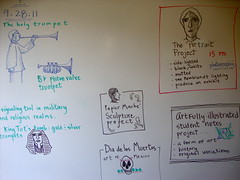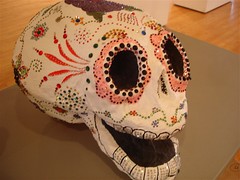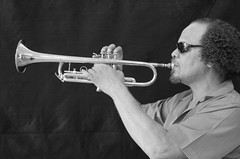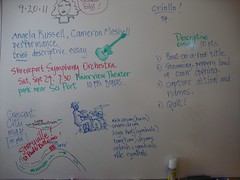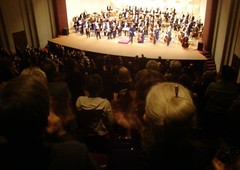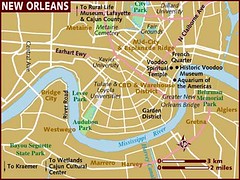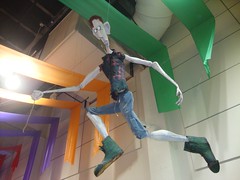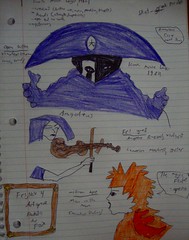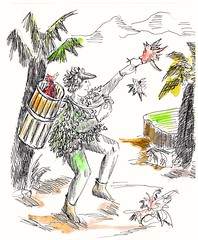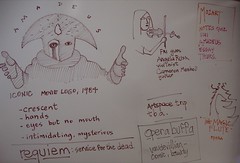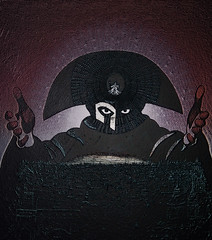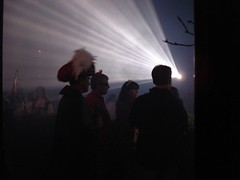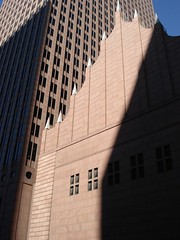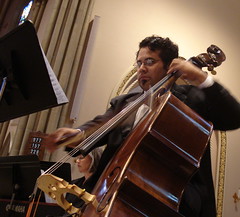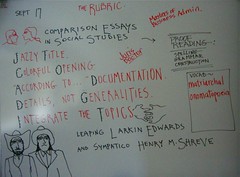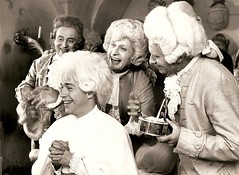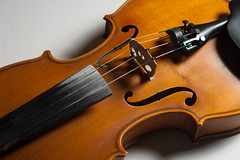Thursday, September 29, 2011
Wednesday, September 28, 2011
Group projects: Dia de los Muertos, papier mache, video, story time, etc
Group projects are an experiment on my part designed to bring more action and appreciation for arts production to Fine Arts survey. The idea is to take some class time and combine it with homework to produce an artful exhibit.
Students will be allowed to work during classroom time as long as they have the materials and exhibit enough organization to satisfy the educational standards of your teacher.
Be aware that as it is an experiment I may have to make adjustments to the schedule.
The due date for all projects will be Tues, Oct 18.
15 pts ea student.
5 pts bonus for early completion.
Students will be allowed to work during classroom time as long as they have the materials and exhibit enough organization to satisfy the educational standards of your teacher.
Be aware that as it is an experiment I may have to make adjustments to the schedule.
The due date for all projects will be Tues, Oct 18.
15 pts ea student.
5 pts bonus for early completion.
The Artful Portrait Project
Criteria -
- dramatic side lighting - see Rembrandt lighting.
- black & white
- matted
- titled and signed
- 5X7 or 8X10
- 3 pieces
- 15 pts
- campus exhibit / online exhibit
Due in class on Oct 10.
- dramatic side lighting - see Rembrandt lighting.
- black & white
- matted
- titled and signed
- 5X7 or 8X10
- 3 pieces
- 15 pts
- campus exhibit / online exhibit
Due in class on Oct 10.
Trumpet player Don Crenshaw / Dirty Red, Shreveport
Trumpets are among the oldest musical instruments,[1] dating back to at least 1500 BCE.
They are played by blowing air through closed lips, producing a "buzzing" sound which starts a standing wave vibration in the air column inside the trumpet.
The typical trumpet is a B flat, piston valve horn.
The bronze and silver trumpets from Tutankhamun's grave in Egypt, bronze lurs from Scandinavia, and metal trumpets from China date back to 1500 BCE.[2] Trumpets from the Oxus civilization (3rd millennium BCE) of Central Asia have decorated swellings in the middle, yet are made out of one sheet of metal, which is considered a technical wonder.[3] The Moche people of ancient Peru depicted trumpets in their art going back to 300 CE.[4]
The earliest trumpets were signaling instruments used for military or religious purposes, rather than music in the modern sense;[5] and the modern bugle continues this signaling tradition.
In medieval times, trumpet playing was a guarded craft, its instruction occurring only within highly selective guilds. The trumpet players were often among the most heavily guarded members of a troop, as they were relied upon to relay instructions to other sections of the army.
piccolo trumpet
pocket trumpet
cornet
flugelhorn
slide trumpet
bugle
bass trumpet
They are played by blowing air through closed lips, producing a "buzzing" sound which starts a standing wave vibration in the air column inside the trumpet.
The typical trumpet is a B flat, piston valve horn.
The bronze and silver trumpets from Tutankhamun's grave in Egypt, bronze lurs from Scandinavia, and metal trumpets from China date back to 1500 BCE.[2] Trumpets from the Oxus civilization (3rd millennium BCE) of Central Asia have decorated swellings in the middle, yet are made out of one sheet of metal, which is considered a technical wonder.[3] The Moche people of ancient Peru depicted trumpets in their art going back to 300 CE.[4]
The earliest trumpets were signaling instruments used for military or religious purposes, rather than music in the modern sense;[5] and the modern bugle continues this signaling tradition.
In medieval times, trumpet playing was a guarded craft, its instruction occurring only within highly selective guilds. The trumpet players were often among the most heavily guarded members of a troop, as they were relied upon to relay instructions to other sections of the army.
piccolo trumpet
pocket trumpet
cornet
flugelhorn
slide trumpet
bugle
bass trumpet
Decorative items that seem to be art but are unoriginal and cheesy: it's kitsch
Kitsch refers to non-original art-like material that has some of the qualities of art. An example: reproductions of the Blue Dog by esteemed Louisiana artist George Rodrigue.
While your teacher is proud that his house is full of original art, he must admit that he has kitsch, too - and it is dear to him. Examples include numerous statuettes of Buddha and Ganesh.
Kitsch /kɪtʃ/ is a term of German or Yiddish origin, says Wikiepdiia, that has been used to categorize art that is considered an inferior, tasteless copy of an existing style.
The contemporary definition of kitsch is derogatory, denoting works executed to pander to popular demand alone and purely for commercial purposes rather than works created as self-expression by an artist.[2] The term is generally reserved for unsubstantial and gaudy works that are calculated to have popular appeal and are considered pretentious and shallow rather than genuine artistic efforts.
Your teacher's parents had a reproduction of an 18th century painting of Venice ("The Palace of the Doge") over the sofa in the living room.
"Nice try, Mom."
It was nicely-framed kitsch.
While your teacher is proud that his house is full of original art, he must admit that he has kitsch, too - and it is dear to him. Examples include numerous statuettes of Buddha and Ganesh.
Kitsch /kɪtʃ/ is a term of German or Yiddish origin, says Wikiepdiia, that has been used to categorize art that is considered an inferior, tasteless copy of an existing style.
The contemporary definition of kitsch is derogatory, denoting works executed to pander to popular demand alone and purely for commercial purposes rather than works created as self-expression by an artist.[2] The term is generally reserved for unsubstantial and gaudy works that are calculated to have popular appeal and are considered pretentious and shallow rather than genuine artistic efforts.
Your teacher's parents had a reproduction of an 18th century painting of Venice ("The Palace of the Doge") over the sofa in the living room.
"Nice try, Mom."
It was nicely-framed kitsch.
Thursday, September 22, 2011
"Equal day and equal night:" the equinox
An equinox occurs twice a year, when the tilt of the Earth's axis is inclined neither away from nor towards the Sun, the center of the Sun being in the same plane as the Earth's equator. The term equinox can also be used in a broader sense, meaning the date when such a passage happens. The name "equinox" is derived from the Latin aequus (equal) and nox (night), because around the equinox, the night and day have approximately equal length.
There are harvest festivals across the globe that coincide with the autumnal equinox.
There are harvest festivals across the globe that coincide with the autumnal equinox.
Ska-boom: a quiz upon the basic tenets of jazz

Jazzing the orchestra with the Marcus Roberts Trio and the Shreveport Symphony Orchestra Sat, Sept 16
Originally uploaded by trudeau
1. First city of jazz: __ __.
2. Second city of Jazz (and of the US in general): __ .
3. Third city to which the fathers of jazz - such as Joe Oliver, Louis
Armstrong and Jellyroll Morton - relocated: __ __ .
4. Movement of impoverished black Americans from the farms of the Deep
South to urban centers of Upper Midwest and Northeast: a) diplomacy b)
dispora c) displacement d) dislocation .
5. Approximate date for the birth of jazz: a) 1800 b) 1850's c)
1900 d) 1920's.
6. Name given to the place in New Orleans where slaves gathered on
Sundays: a) river levees b) Ashanti circle c) Place Congo d) Vieux
Carre.
7. Louisiana term for people of mixed ethnic background, esp. a
mixture of French, Spanish, native American and Afro-Caribbean: __ .
8. Gens de couleur libre was a special ethnic category in NO. It
indicated a person who was African-American, yet not a slave. T / F
9. Another name for the historic French Quarter is Vieux Carre; it
means: a) Spanish Quarter b) Old Quarter c) French District d)
Slave Quarters .
10. A radical change in his instrument's shape was the signature of
bebop jazz artist Dizzy Gilespie. His instrumentwas the ____ .
11. Gillespie, Ella Fitzgerald and other jazzers offered vocal
improvisation with random vocables and syllables or without words at
all. This is called __ singing.
12. World War I and the Immigration Act of 1924 halted the flow of
European immigrants to the emerging industrial centers of the
Northeast and Midwest, causing shortages of workers in the factories
and openings for immigrating African-Americans. T / F
13. Chronological order of the development of jazz: a) Dixieland,
big band-style swing, bebop, Latin jazz, free jazz b) big band-style
swing, Dixieland, bebop, Latin jazz, free jazz c) bebop, Dixieland,
big band-style swing, Latin jazz, free jazz
14. In jazz the skilled performer will interpret a tune in very
individual ways, never playing the same composition exactly the same
way twice. Thus while jazz may be difficult to define, ______ is
clearly one of its key elements.
a) swing b) improvisation c) syncopation d) concentration.
1. New Orleans
2. Chicago
3. NYC (Harlem is not a city; it is a neighborhood in NYC)
4. diaspora
5. 1900
6. Place Congo, or Congo Square
7. Creole
8. T
9. Old Quarter
10. trumpet
11.scat
12. T
13. Dixieland, swing, bebop, etc
14. improvisation
Wednesday, September 21, 2011
Magnet fine arts: descriptive essays on performance by Angela Russell & Cameron Meshell and description of the esteemed movie Amadeus
1. Ju Ju title!
2. Jambo opening.
3. Action and names.
4. That's it!
10 pts.
Amadeus, the award-winning movie: 1) Cannon-shot title 2) Colorful opening 3) 2-sentence plot synopsis 4) quotes (2) 5) Strengths and weaknesses 6) documentation.
2. Jambo opening.
3. Action and names.
4. That's it!
10 pts.
Amadeus, the award-winning movie: 1) Cannon-shot title 2) Colorful opening 3) 2-sentence plot synopsis 4) quotes (2) 5) Strengths and weaknesses 6) documentation.
Shreveport Symphony Orchestra: student tickets $10 cash on Sat night
Special price for students on Sat night, says Cathy Sholar, at the ticket window in the lobby of Riverview Theater: $10 c a s h (rather than the usual $12).
Dollar per bonus point: 10 pts.
Wave at me in the lobby at intermission!
Dollar per bonus point: 10 pts.
Wave at me in the lobby at intermission!
Friday, September 16, 2011
New Orleans map project: 10 pts on Tues
Sketch (trace) and color a map of the Crescent City. Please include -
- French Quarter / Vieux Carre
- Bourbon St
- Canal St
- St Charles Ave
- Louis Armstrong Park / Place Congo
- site of Storyville red light district
- Lake Pontchartrain
- Mississippi R
- French Quarter / Vieux Carre
- Bourbon St
- Canal St
- St Charles Ave
- Louis Armstrong Park / Place Congo
- site of Storyville red light district
- Lake Pontchartrain
- Mississippi R
From Mozart to Jellyroll Morton / Jazz reports due next week
Jazz your baby! Jazz me, sister!
The music called jazz is varied and the definition is problematic.
Nonetheless, you will develop an appreciation for early jazz as played in New Orleans and Chicago, for swing jazz as born in New York, and for bebop and cool jazz, also birthed in NYC.
Graphic report on jazz personalities (15 pts) -
- 5 images/slides, 3 bits of historic material upon each.
- Musical sample.
- documentation.
- 3 review questions at end: multiple choice, ranging in difficulty from easy to challenging, but not "picky."
Jazz musicians with the highest status in this American art form -
1. Jellyroll Morton
2. Joe King Oliver
3. Louis Armstrong
4. Fletcher Henderson
5. Charlie Parker
6. Edward Duke Ellington
7. William Count Basie
8. Benny Goodman
9. Glenn Miller
10. Lionel Hampton
11. Charlie Christian
12. Charlie Bird Parker
13. Dizzy Gillespie
14. Thelonius Monk
15. Miles Davis
16. John Coltrane
17. Charles Mingus
18. Billie Holiday
19. Ella Fitzgerald
20. Nat King Cole
21. Herbie Hancock
22. Wynton Marsalis
23. George Gershwin, classical / jazz
24. Leonard Bernstein, classical / jazz
Your report topic will be assigned by class roll number.
The music called jazz is varied and the definition is problematic.
Nonetheless, you will develop an appreciation for early jazz as played in New Orleans and Chicago, for swing jazz as born in New York, and for bebop and cool jazz, also birthed in NYC.
Graphic report on jazz personalities (15 pts) -
- 5 images/slides, 3 bits of historic material upon each.
- Musical sample.
- documentation.
- 3 review questions at end: multiple choice, ranging in difficulty from easy to challenging, but not "picky."
Jazz musicians with the highest status in this American art form -
1. Jellyroll Morton
2. Joe King Oliver
3. Louis Armstrong
4. Fletcher Henderson
5. Charlie Parker
6. Edward Duke Ellington
7. William Count Basie
8. Benny Goodman
9. Glenn Miller
10. Lionel Hampton
11. Charlie Christian
12. Charlie Bird Parker
13. Dizzy Gillespie
14. Thelonius Monk
15. Miles Davis
16. John Coltrane
17. Charles Mingus
18. Billie Holiday
19. Ella Fitzgerald
20. Nat King Cole
21. Herbie Hancock
22. Wynton Marsalis
23. George Gershwin, classical / jazz
24. Leonard Bernstein, classical / jazz
Your report topic will be assigned by class roll number.
Thursday, September 15, 2011
Fantastic Mr Fox field trip on Tues, Nov 8
Artspace is the destination on Tues, Nov 8, during fine arts classes (2 separate filed trips).
Parents are encouraged to meet us at Artspace to enjoy the experience.
Parents are encouraged to meet us at Artspace to enjoy the experience.
Wednesday, September 14, 2011
Recommended movie and book: The Help
The Help is a movie about bi*chy middle-class women in Jackson, Ms, and the ways in which they mentally abuse their domestic employees.
It's a well-made movie, if a melodrama. But it is recommendable for its observations on racism and life in the civil rights era in the Deep South.
It's a well-made movie, if a melodrama. But it is recommendable for its observations on racism and life in the civil rights era in the Deep South.
The crescent crown atop the head of the late Commandatore in the opera Don Giovanni
The crescent-shaped hat shown atop the ghost of the Commander in Mozart's opera Don Giovanni is called a chapeau bras.
A chapeau bras is a three-cornered hat worn by gentlemen in full dress in the 18th century, that could be folded flat and carried under the arm (chapeau, French for 'hat' and bras, French for 'arm').
Its shape implies
- a battleaxe
- the crescent moon, as in the crescent and star symbol of Islam.
- a crescent wrench.
- crescent roll, or croissant.
- the wings of an eagle.
additional vocab -
- scatalogical: humor dealing with bodily functions such as farting or peepeeing. Or, in the field of anthropology, study of fecal matter (skat, Gk) and the deductions thereupon.
- opera buffa: a comic opera characterized by everyday settings, local dialects, and simple vocal writing. The type of comedy could vary, and the range was great: from Rossini's The Barber of Seville in 1816 which was purely comedic, to Mozart's The Marriage of Figaro in 1786 which added drama and pathos, says Wikipedia.
A chapeau bras is a three-cornered hat worn by gentlemen in full dress in the 18th century, that could be folded flat and carried under the arm (chapeau, French for 'hat' and bras, French for 'arm').
Its shape implies
- a battleaxe
- the crescent moon, as in the crescent and star symbol of Islam.
- a crescent wrench.
- crescent roll, or croissant.
- the wings of an eagle.
additional vocab -
- scatalogical: humor dealing with bodily functions such as farting or peepeeing. Or, in the field of anthropology, study of fecal matter (skat, Gk) and the deductions thereupon.
- opera buffa: a comic opera characterized by everyday settings, local dialects, and simple vocal writing. The type of comedy could vary, and the range was great: from Rossini's The Barber of Seville in 1816 which was purely comedic, to Mozart's The Marriage of Figaro in 1786 which added drama and pathos, says Wikipedia.
Mozart's last great work, the opera called The Magic Flute (Die Zauberflote)
The Magic Flute (German: Die Zauberflöte, K. 620) is an opera in two acts composed in 1791 by Wolfgang Amadeus Mozart to a German libretto by Emanuel Schikaneder.
The work is in the form of a Singspiel, says Wikipedia, a popular form that included both singing and spoken dialogue.[1]
Although there were no reviews of the first performances, it was immediately evident that Mozart and Schikaneder had achieved a great success, the opera drawing immense crowds and reaching hundreds of performances during the 1790s.[4]
The success of The Magic Flute lifted the spirits of its composer, who had fallen ill while in Prague a few weeks before. Solomon continues:
Mozart's delight is reflected in his last three letters, written to Constanze, who with her sister Sophie was spending the second week of October in Baden. "I have this moment returned from the opera, which was as full as ever," he wrote on 7 October, listing the numbers that had to be encored. "But what always gives me the most pleasure is the silent approval! You can see how this opera is becoming more and more esteemed." … He went to hear his opera almost every night, taking along [friends and] relatives.[4]
The opera celebrated its 100th performance in November 1792. Mozart did not have the pleasure of witnessing this milestone, having died of his illness on 5 December 1791.
The work is in the form of a Singspiel, says Wikipedia, a popular form that included both singing and spoken dialogue.[1]
Although there were no reviews of the first performances, it was immediately evident that Mozart and Schikaneder had achieved a great success, the opera drawing immense crowds and reaching hundreds of performances during the 1790s.[4]
The success of The Magic Flute lifted the spirits of its composer, who had fallen ill while in Prague a few weeks before. Solomon continues:
Mozart's delight is reflected in his last three letters, written to Constanze, who with her sister Sophie was spending the second week of October in Baden. "I have this moment returned from the opera, which was as full as ever," he wrote on 7 October, listing the numbers that had to be encored. "But what always gives me the most pleasure is the silent approval! You can see how this opera is becoming more and more esteemed." … He went to hear his opera almost every night, taking along [friends and] relatives.[4]
The opera celebrated its 100th performance in November 1792. Mozart did not have the pleasure of witnessing this milestone, having died of his illness on 5 December 1791.
Mozart quiz Fri, Amadeus essay Thurs next week
A Requiem or Requiem Mass, also known as Mass for the dead (Latin: Missa pro defunctis), is Mass celebrated for the repose of the soul or souls of a deceased person, using a particular formula of the Roman Missal. It is frequently celebrated in the context of a funeral. Musical settings of the propers of the Requiem Mass are also called Requiems.
The liturgy begins with the words "Requiem aeternam dona eis, Domine" – "Grant them eternal rest, O Lord."
This is as the Kyrie in the Ordinary of the Mass, not from the Latin but from Greek: Kyrie eleison; Christe eleison; Kyrie eleison Lord have mercy; Christ have mercy; Lord have mercy.
The Requiem Mass in D minor (K. 626) by Wolfgang Amadeus Mozart was composed in Vienna in 1791 and left unfinished at the composer's death.
Finding detail and background on Amadeus at Imdb.com
- Amadeus" is most often translated to mean "loves God", "lover of God", or "for the love of God".
- Was Mozart the goofball as depicted in this film?
Not in Marcia Davenport's biography of Mozart, 1932.
At least in private, Mozart could be crude. In his letters he could be quite insulting and had a love of scatological humor. He wrote canons with titles like "Leck mich im Arsch" (Lick My Ass). He also loved to drink, party and gamble, often spending copious amounts of money.
Another point is that almost all of Mozart's dialog spoken in the movie was Mozart's own words, translated from the German, of course, taken from his letters and other sources.
- Antonio Salieri (1750-1825) was a real person, an Italian composer and conductor. As the Austrian imperial Kapellmeister from 1788 to 1824, he was one of the most important and famous musicians of his time. However, as near as it's possible to tell, he was not out to kill Mozart. Although they competed for some commissions, all indications are that they had a friendly relationship. Salieri lent Mozart court manuscripts and even tutored one of his sons.
- Antonio Salieri (1750-1825) was a real person, an Italian composer and conductor. As the Austrian imperial Kapellmeister from 1788 to 1824, he was one of the most important and famous musicians of his time.
However, as near as it's possible to tell, he was not out to kill Mozart. Although they competed for some commissions, all indications are that they had a friendly relationship. Salieri lent Mozart court manuscripts and even tutored one of his sons.
- Your essay on Amadeus should be built around pertinent quotes. Imdb offers numerous quotes -
- Emperor Joseph II: "My dear young man, don't take it too hard. Your work is ingenious. It's quality work. And there are simply too many notes, that's all. Just cut a few and it will be perfect."
- Mozart: "Which few did you have in mind, Majesty?"
- This touches upon the nature of art and artistic criticism. Mozart's sharp response brings up the nature of the artist and independence.
- Katerina Cavalieri: "Looks don't concern me, Maestro. Only talent interests a woman of taste." This reminds us of the appeal of art and artists and the conflict that lies in success.
Words of Mozart from an admirer on Flickr.com:
"As death, when we come to consider it closely, is the true goal of our existence, I have formed during the last few years such close relations with this best and truest friend of mankind, that his image is not only not terrifying to me, but is indeed very soothing and consoling! And i thank my God for graciously granting me the opportunity.... of learning that death is the key which unlocks the door to our true happiness"
"Neither a lofty degree of intelligence nor imagination nor both together go to the making of genius. Love, love, love ,that is the soul of genius."
"people make a mistake who think that my art has come easily to me. Nobody has devoted so much time and thought to composition as I. There is not a famous master whose work i have not studied over and over."
- Was Mozart the goofball as depicted in this film?
Not in Marcia Davenport's biography of Mozart, 1932.
At least in private, Mozart could be crude. In his letters he could be quite insulting and had a love of scatological humor. He wrote canons with titles like "Leck mich im Arsch" (Lick My Ass). He also loved to drink, party and gamble, often spending copious amounts of money.
Another point is that almost all of Mozart's dialog spoken in the movie was Mozart's own words, translated from the German, of course, taken from his letters and other sources.
- Antonio Salieri (1750-1825) was a real person, an Italian composer and conductor. As the Austrian imperial Kapellmeister from 1788 to 1824, he was one of the most important and famous musicians of his time. However, as near as it's possible to tell, he was not out to kill Mozart. Although they competed for some commissions, all indications are that they had a friendly relationship. Salieri lent Mozart court manuscripts and even tutored one of his sons.
- Antonio Salieri (1750-1825) was a real person, an Italian composer and conductor. As the Austrian imperial Kapellmeister from 1788 to 1824, he was one of the most important and famous musicians of his time.
However, as near as it's possible to tell, he was not out to kill Mozart. Although they competed for some commissions, all indications are that they had a friendly relationship. Salieri lent Mozart court manuscripts and even tutored one of his sons.
- Your essay on Amadeus should be built around pertinent quotes. Imdb offers numerous quotes -
- Emperor Joseph II: "My dear young man, don't take it too hard. Your work is ingenious. It's quality work. And there are simply too many notes, that's all. Just cut a few and it will be perfect."
- Mozart: "Which few did you have in mind, Majesty?"
- This touches upon the nature of art and artistic criticism. Mozart's sharp response brings up the nature of the artist and independence.
- Katerina Cavalieri: "Looks don't concern me, Maestro. Only talent interests a woman of taste." This reminds us of the appeal of art and artists and the conflict that lies in success.
Words of Mozart from an admirer on Flickr.com:
"As death, when we come to consider it closely, is the true goal of our existence, I have formed during the last few years such close relations with this best and truest friend of mankind, that his image is not only not terrifying to me, but is indeed very soothing and consoling! And i thank my God for graciously granting me the opportunity.... of learning that death is the key which unlocks the door to our true happiness"
"Neither a lofty degree of intelligence nor imagination nor both together go to the making of genius. Love, love, love ,that is the soul of genius."
"people make a mistake who think that my art has come easily to me. Nobody has devoted so much time and thought to composition as I. There is not a famous master whose work i have not studied over and over."
Tuesday, September 13, 2011
3rd annual North Louisiana Gay & Lesbian Film Festival to be held September 16-22, 2011, at the Robinson Film Center
The 3rd annual North Louisiana Gay & Lesbian Film Festival will be held Sept 16-22, 2011, at the Robinson Film Center in downtown Shreveport with celebrity guest Bruce Vilanch.
For more info: www.nlglff.org
Tickets and Festival passes are on sale now at the Robinson Film Center box office.
Individual tickets can be purchased online at http://www.robinsonfilmcenter.org/movies.
For more info: www.nlglff.org
Tickets and Festival passes are on sale now at the Robinson Film Center box office.
Individual tickets can be purchased online at http://www.robinsonfilmcenter.org/movies.
One of the most-performed of all operas: Mozart's Don Giovanni
Don Giovanni ( The Rake Punished, or Don Giovanni) is an opera in two acts with music by Wolfgang Amadeus Mozart and with an Italian libretto by Lorenzo Da Ponte, says Wikipedia.
It was premiered by the Prague Italian opera in 1787.
Da Ponte's libretto was billed like many of its time as dramma giocoso, a term that denotes a mixing of serious and comic action. Mozart entered the work into his catalogue as an "opera buffa". Although sometimes classified as comic, it blends comedy, melodrama and supernatural elements.
The synopsis: Don Giovanni, a young, arrogant, sexually promiscuous nobleman, abuses and outrages everyone else in the cast, until he encounters something he cannot kill, beat up, dodge, or outwit.
It was premiered by the Prague Italian opera in 1787.
Da Ponte's libretto was billed like many of its time as dramma giocoso, a term that denotes a mixing of serious and comic action. Mozart entered the work into his catalogue as an "opera buffa". Although sometimes classified as comic, it blends comedy, melodrama and supernatural elements.
The synopsis: Don Giovanni, a young, arrogant, sexually promiscuous nobleman, abuses and outrages everyone else in the cast, until he encounters something he cannot kill, beat up, dodge, or outwit.
Monday, September 12, 2011
Wigs of the royals in Europe
Royal patronage was crucial to the revival of the wig, says Wikipedia.[citation needed]
Queen Elizabeth I of England famously wore a red wig, tightly and elaborately curled in a "Roman" style.
King Louis XIII of France (1601–1643) and King Louis XIV of France (1638–1715) pioneered wig-wearing among men from the 1620s onwards.
Perukes or periwigs for men were introduced into the English-speaking world with other French styles when Charles II was restored to the throne in 1660, following a lengthy exile in France. These wigs were shoulder-length or longer, imitating the long hair that had become fashionable among men since the 1620s.
In the 18th century, men's wigs were powdered in order to give them their distinctive white or off-white color. Contrary to popular belief, women in the 18th century did not wear wigs, but wore a coiffure supplemented by artificial hair or hair from other sources.
During the late 18th century, men's wigs became smaller and more formal with several professions adopting them as part of their official costumes.
The wearing of wigs as a symbol of social status was largely abandoned in the newly created United States and France by the start of the 19th century. In the United States, only the first five Presidents, from George Washington to James Monroe, wore powdered wigs according to the old fashioned style of the eighteenth century.[3][4]
Queen Elizabeth I of England famously wore a red wig, tightly and elaborately curled in a "Roman" style.
King Louis XIII of France (1601–1643) and King Louis XIV of France (1638–1715) pioneered wig-wearing among men from the 1620s onwards.
Perukes or periwigs for men were introduced into the English-speaking world with other French styles when Charles II was restored to the throne in 1660, following a lengthy exile in France. These wigs were shoulder-length or longer, imitating the long hair that had become fashionable among men since the 1620s.
In the 18th century, men's wigs were powdered in order to give them their distinctive white or off-white color. Contrary to popular belief, women in the 18th century did not wear wigs, but wore a coiffure supplemented by artificial hair or hair from other sources.
During the late 18th century, men's wigs became smaller and more formal with several professions adopting them as part of their official costumes.
The wearing of wigs as a symbol of social status was largely abandoned in the newly created United States and France by the start of the 19th century. In the United States, only the first five Presidents, from George Washington to James Monroe, wore powdered wigs according to the old fashioned style of the eighteenth century.[3][4]
In Mozart's world: French Queen Marie-Antoinette, 1775, and decolletage
Décolletage (or décolleté, its adjectival form, in current French) is the upper part of a woman's torso, comprising her neck, shoulders, back and chest, that is exposed by the style of her clothing. Décolletage is a French word which is derived from decolleter, meaning to reveal the neck or, more literally, "without a collar," says Wikipedia.
Gowns which exposed a woman's neck and top of her chest were very common and non-controversial in Europe from at least the 11th century. The wearing of low-cut dresses which exposed breasts were considered more acceptable than they are today; with a woman's bared legs, ankles, or shoulders being considered to be more risqué than exposed breasts.[6]
From the Victorian period onward, however, social attitudes shifted to demand a woman's breasts to be covered in public. For ordinary wear, high collars were the norm for many years.
Victorian morality reflects Queen Victoria's reign (1837–1901) and the moral climate of the United Kingdom throughout the 19th century in general, which contrasted greatly with the morality of the previous Georgian period.
Victorian morality espouses sexual restraint, low tolerance of crime and a strict social code of conduct. Due to the prominence of the British Empire, many of these values were spread across the world.
Gowns which exposed a woman's neck and top of her chest were very common and non-controversial in Europe from at least the 11th century. The wearing of low-cut dresses which exposed breasts were considered more acceptable than they are today; with a woman's bared legs, ankles, or shoulders being considered to be more risqué than exposed breasts.[6]
From the Victorian period onward, however, social attitudes shifted to demand a woman's breasts to be covered in public. For ordinary wear, high collars were the norm for many years.
Victorian morality reflects Queen Victoria's reign (1837–1901) and the moral climate of the United Kingdom throughout the 19th century in general, which contrasted greatly with the morality of the previous Georgian period.
Victorian morality espouses sexual restraint, low tolerance of crime and a strict social code of conduct. Due to the prominence of the British Empire, many of these values were spread across the world.
Classical in the late 1700's, early 1800's - a more specific meaning
In the middle of the 18th century, Europe began to move toward a new style in architecture, literature, and the arts, generally known as Classicism, which sought to emulate the ideals of Classical antiquity and especially those of Classical Greece.[2]
While still tightly linked to the court culture, says Wikipedia, and absolutism, with its formality and emphasis on order and hierarchy, the new style was also a cleaner style—one that favored clearer divisions between parts, brighter contrasts and colors, and simplicity rather than complexity.
The remarkable development of ideas in "natural philosophy" had established itself in the public consciousness with Newton's physics taken as a paradigm: structures should be well-founded in axioms and be both well-articulated and orderly.
This taste for structural clarity worked its way into the world of music, moving away from the layered polyphony of the Baroque period, towards a style where a melody over a subordinate harmony—a combination called homophony—was preferred.[3]
This meant that the playing of chords, even if they interrupted the melodic smoothness of a single part, became a much more prevalent feature of music. This, in turn, made the tonal structure of works more audible.
Classical music has a lighter, clearer texture than Baroque music and is less complex.
Variety and contrast within a piece became more pronounced than before. Variety of keys, melodies, rhythms and dynamics (using crescendo, diminuendo and sforzando), along with frequent changes of mood and timbre were more commonplace in the Classical period than they had been in the Baroque. Melodies tended to be shorter than those of Baroque music, with clear-cut phrases and clearly marked cadences. The Orchestra increased in size and range; the harpsichord continuo fell out of use, and the woodwind became a self-contained section. As a solo instrument, the harpsichord was replaced by the piano (or fortepiano).
While still tightly linked to the court culture, says Wikipedia, and absolutism, with its formality and emphasis on order and hierarchy, the new style was also a cleaner style—one that favored clearer divisions between parts, brighter contrasts and colors, and simplicity rather than complexity.
The remarkable development of ideas in "natural philosophy" had established itself in the public consciousness with Newton's physics taken as a paradigm: structures should be well-founded in axioms and be both well-articulated and orderly.
This taste for structural clarity worked its way into the world of music, moving away from the layered polyphony of the Baroque period, towards a style where a melody over a subordinate harmony—a combination called homophony—was preferred.[3]
This meant that the playing of chords, even if they interrupted the melodic smoothness of a single part, became a much more prevalent feature of music. This, in turn, made the tonal structure of works more audible.
Classical music has a lighter, clearer texture than Baroque music and is less complex.
Variety and contrast within a piece became more pronounced than before. Variety of keys, melodies, rhythms and dynamics (using crescendo, diminuendo and sforzando), along with frequent changes of mood and timbre were more commonplace in the Classical period than they had been in the Baroque. Melodies tended to be shorter than those of Baroque music, with clear-cut phrases and clearly marked cadences. The Orchestra increased in size and range; the harpsichord continuo fell out of use, and the woodwind became a self-contained section. As a solo instrument, the harpsichord was replaced by the piano (or fortepiano).
Thursday, September 8, 2011
Mozart and Joseph II: vocab and personalities
- Vienna in the 1700's was like today's NYC; a capital of music and the arts.
- Emperor Joseph II, Vienna, was ruler of the Holy Roman Empire. He was an enlightened (knew the Rights of Man) despot (dictator) acting on a definite system for the good of all.
- emancipation of the peasantry
- spread of education
- the secularization of church lands
- the reduction of the religious orders and the clergy
- limited guarantee of freedom of worship,
- unity by the compulsory use of the German language
- abolished serfdom
- peasants must be paid in cash payments rather than labor obligations.
- a lover and patron of the arts.
These policies were violently rejected by both the nobility and the peasants, since their barter economy lacked money.
Antonio Salieri - a cosmopolitan composer who wrote operas in three languages.
- helped to develop many of the features of operatic compositional vocabulary; his music was a powerful influence on contemporary composers.
- also spent time writing works for opera houses in Venice, Rome, and Paris.
- one of the most important and sought after teachers of his generation and his influence was felt in every aspect of Vienna's musical life.
- among his famous pupils: Franz Liszt, Schubert, Ludwig van Beethoven.
Mozart's first great opera: The Abduction from the Seraglio, or the Harem, is a lighthearted piece in German.
Harem (Turkish, from Arabic حرم ḥaram 'forbidden place; sacrosanct, sanctum', related to حريم ḥarīm 'a sacred inviolable place; female members of the family' and حرام ḥarām, 'forbidden; sacred') refers to the sphere of women in what is usually a polygynous (as opposed to polyandrous) household and their enclosed quarters which are forbidden to men. It originated in the Near East and is typically associated in the Western world with the Ottoman Empire.
Libretto (pl. libretti), from Italian, is the diminutive of the word "libro" (book). A libretto is distinct from a synopsis or scenario of the plot, in that the libretto contains all the words and stage directions, while a synopsis summarizes the plot.
- Emperor Joseph II, Vienna, was ruler of the Holy Roman Empire. He was an enlightened (knew the Rights of Man) despot (dictator) acting on a definite system for the good of all.
- emancipation of the peasantry
- spread of education
- the secularization of church lands
- the reduction of the religious orders and the clergy
- limited guarantee of freedom of worship,
- unity by the compulsory use of the German language
- abolished serfdom
- peasants must be paid in cash payments rather than labor obligations.
- a lover and patron of the arts.
These policies were violently rejected by both the nobility and the peasants, since their barter economy lacked money.
Antonio Salieri - a cosmopolitan composer who wrote operas in three languages.
- helped to develop many of the features of operatic compositional vocabulary; his music was a powerful influence on contemporary composers.
- also spent time writing works for opera houses in Venice, Rome, and Paris.
- one of the most important and sought after teachers of his generation and his influence was felt in every aspect of Vienna's musical life.
- among his famous pupils: Franz Liszt, Schubert, Ludwig van Beethoven.
Mozart's first great opera: The Abduction from the Seraglio, or the Harem, is a lighthearted piece in German.
Harem (Turkish, from Arabic حرم ḥaram 'forbidden place; sacrosanct, sanctum', related to حريم ḥarīm 'a sacred inviolable place; female members of the family' and حرام ḥarām, 'forbidden; sacred') refers to the sphere of women in what is usually a polygynous (as opposed to polyandrous) household and their enclosed quarters which are forbidden to men. It originated in the Near East and is typically associated in the Western world with the Ottoman Empire.
Libretto (pl. libretti), from Italian, is the diminutive of the word "libro" (book). A libretto is distinct from a synopsis or scenario of the plot, in that the libretto contains all the words and stage directions, while a synopsis summarizes the plot.
Tuesday, September 6, 2011
Scan or photograph all hand-produced papers; save all writing to your hard drive or email
Record keeping is a lifetime sport.
It's not a sport, is it? It's work. Yet if you make it a habit, it will become easier.
Working in the digital realm makes record keeping a lot easier than it once was.
Save all work til the end of the semester. You never know when it will be advantageous.
It's not a sport, is it? It's work. Yet if you make it a habit, it will become easier.
Working in the digital realm makes record keeping a lot easier than it once was.
Save all work til the end of the semester. You never know when it will be advantageous.
Where are the women in history? Why are so few women recognized in the arts?
One theme for fine arts classes is an inquiry into the place of women in the arts. Why are they so under-represented? Of course, the search can be extended to technology and professional services, too.
Where are the women in history? Why do we see such an imbalance until recent times?
There's no easy answer. Your teacher's thesis is that women have created equal amounts of art but were denied recognition by the male-dominated European way.
Where are the women that might equal Bach, Mozart and Beethoven in composing? One answer lies in the tragic story of Mozart's sister, Maria Anna.
While she was feted as a prodigy when she and Wolfgang were young, Mozart's father later suppressed her talent.
He wanted the son to have clear access to the glory.
If Maria Anna had developed the strength to defy her father, would she have produced worthy compositions? I would feel confident in answering, "Yes."
I invite my students to follow this line of inquiry and develop your own theses.
Where are the women in history? Why do we see such an imbalance until recent times?
There's no easy answer. Your teacher's thesis is that women have created equal amounts of art but were denied recognition by the male-dominated European way.
Where are the women that might equal Bach, Mozart and Beethoven in composing? One answer lies in the tragic story of Mozart's sister, Maria Anna.
While she was feted as a prodigy when she and Wolfgang were young, Mozart's father later suppressed her talent.
He wanted the son to have clear access to the glory.
If Maria Anna had developed the strength to defy her father, would she have produced worthy compositions? I would feel confident in answering, "Yes."
I invite my students to follow this line of inquiry and develop your own theses.
Vocab for comparing all things - including composers
Use several of these terms in essays of comparison -
- similarly
- yet
- but
- however
- still
- nevertheless
- in contrast
- conversely
- instead
- likewise
- on one hand
- on the other hand
- on the contrary
- rather
- similarly
- yet
- but
- however
- still
- nevertheless
- in contrast
- conversely
- instead
- likewise
- on one hand
- on the other hand
- on the contrary
- rather
Sunday, September 4, 2011
Fine arts essay comparing Bach, Mozart and Beethoven
In your brief comparison essay on 3 great composers, please include -
- names of each composers' most notable works (3 each)
- location(s)
- dates / eras
- impact upon contemporary life
- informal documentation ("according to Wikipedia,")
- Colorful, expressive title
- names of each composers' most notable works (3 each)
- location(s)
- dates / eras
- impact upon contemporary life
- informal documentation ("according to Wikipedia,")
- Colorful, expressive title
Twenty-nine questions that guide a student in viewing the movie Amadeus
A review of details from the award-winning movie Amadeus -
1. How does Mozart propose to Constanza?
- He says it backwards. 'Em yrram.' Mozart finds speaking backwards very amusing, especially when obscenities are involved.
2. What does Salieri NOT include in his promise to God?
- The virtue of charity. He said, 'In return I give you my chastity, my industry, my deepest humility- every hour of my life.'
3. How do the Mozarts secure extra money when it is quickly and desperately needed?
- They pawn household objects. Gold snuffboxes to be exact.
4. How many times is the opera Don Giovanni played in Vienna?
- Five. Salieri said, 'Through my influence, I saw to it Don Giovanni was played only five times in Vienna - but in secret I went to every one of those five, worshipping the sound that I alone seemed to hear.'
5. The first time we see Mozart as a child, for whom is he performing?
- For the Pope. He plays the harpsicord blindfolded, then repeats the same tune on the violin.
6. The first time we see Mozart as an adult, for whom is he performing?
- The Archbishop of Salzburg. He makes an embarrassingly late appearance because he's fooling around with Constanza.
7. What is the first of Mozart's operas we hear parodied in the common theater?
- Don Giovanni. The ghost of Don Giovanni's father is played by a midget.
8. How many years pass between Mozart's death and Salieri's attempted suicide?
- 32. '...and he kept me alive to torture! Thirty-two years of torture, thirty-two years!'
9. What is Constanza's 'penalty' for losing a round of musical chairs?
- To show her legs. A very risque' act for the day!
10. What is the name of the Mozarts' maid? Laurel. She's hired by Salieri, who uses her as a spy.
11. How old was Mozart when he composed his first symphony?
- Age seven. 'This man had written his first Concerto at the age of four, his first symphony at seven, a full-scale opera at twelve!'
12. How many Italians serve as the Emperor's musical advisors?
- There are three. All musical idiots, according to Mozart.
13. Where does Constanza go to get her health back?
- The spa. She was sent away by her mother, after Wolfgang's drinking and erratic behavior took their toll on her.
14. Who from the cast was nominated for a Best Actor Oscar?
- Both principal actors were. Abraham won, but graciously remembered Hulce in his speech.
15. What did Salieri's father call the child Mozart?
- Old man Salieri called him "A trained monkey." Salieri the child wanted to make music. His father asked him if he wanted to be a trained monkey like the young Mozart. Throughout his youth, Mozart and his sister Nannerl toured the palaces of Europe as child prodigies. Other detractors also referred to the child Mozart as a trained monkey. More of a reflection upon the father than the child?
16. What did Salieri call Mozart?
- "The creature." In fact, Mozart had a puerile, scataogical sense of humor. He enjoyed speaking backwards and had a high, strange laugh.
17. Who is Mozart's employer when the movie begins?
- The Prince-Archbishop of Salzburg. Mozart was unhappy working under the patronage system of his day. His employment with the prince archbishop was frustrating and stifling. The last 10 years of his life (age 25-35) Mozart strove to be a successful independent musician. If he had lived longer, he might have been the first composer to triumph over the patronage system. As it happened, Beethoven is credited with being the first.
18. Although Constanze and Mozart had six children, only two lived to adulthood. How many were shown in the movie?
- One. Only Karl Thomas is shown in the movie, and the child never says a word! In truth, Constanze gave birth to a son, Franz Xaver Wolfgang, in July 1791, 5 months before Mozart died. This pregnancy/child was never shown or mentioned in the movie. (There has been some speculation about the paternity of Franz Xaver.) Of the six children, Karl Thomas and Franz Xaver Wolfgang were the only two who survived into adulthood. Salieri actually taught Karl Thomas as a composition student after Mozart's death. He taught him for free.
19. In 1984 "Amadeus" won eight Academy Awards, including Best Picture and Best Actor. Who won the Best Actor award?
- Salieri: the actor F. Murray Abraham. Ironically, Salieri (Abraham) finally beat Wolfgang (Hulce) at something.
20. Who was Emperor Joseph's famous sister? (The child Mozart asked her to marry him.)
- Marie Antoinette. Emperor Joseph mentions her several times in the movie. He references the time that the child Mozart asked her to marry him and he later mentions that his dear sister Antoinette "is beginning to fear her own people"... smart girl. Her own people finally guillotined her. Maria Theresa was Joseph's and Antoinette's mother and Elizabeth was Joseph's niece.
21. What mask does Leopold choose for the costume party scene?
- Tragedy/comedy. This is the mask that is resurrected for Salieri's harassment of Mozart in the movie. In truth, the strange circumstances surrounding the "Requiem" commissioning are thought to be the work of Count Walsegg, a nobleman who was notorious for commissioning compositions and trying to pass them off as his own.
22. What did Count Orsini-Rosenberg remove from "The Marriage of Figaro" score?
- The dance scene. Count Orsini-Rosenberg was the Italian born master of opera in the court of Emperor Joseph II. Viennese composers were required to get his permission before beginning work on a new opera.
23. "The Magic Flute" is classified as "singspiel". What does Schickaneder call it in the movie? He calls it a vaudeville. "Singspiel" is very much like musical comedy. Vaudeville describes it well. In the hands of a genius such as Mozart, however, the resulting "Magic Flute" transcends the genre and becomes a masterpiece. Recommended: http://detnews.com/showtime/9710/16/opera/opera.htm ...a fascinating comparison of "The Magic Flute" and "Star Wars".
24. According to the movie, from whom does Mozart get his inspiration for the Queen of the Night's famous aria?
- Frau Weber (his mother-in-law). I don't know if this scene has any historical basis, but it is a rich moment in the film! Originally, Frau Weber was Mozart's landlady. He fell in love with her older daughter who did not return his affections. Then he turned his attention to Constanze, the younger. Maria Magdalena Hoffdeml is the focus of great rumor and speculation concerning Mozart. Although she is never seen or mentioned in the movie, Maria was Mozart's piano student and alleged mistress. One of the Mozart death theories has Maria's angry husband attempting to murder her, poisoning Mozart, and committing suicide. Maria was pregnant during all this, supposedly with Mozart's child.
25. Whom does the movie portray as the commissioner of Mozart's "Requiem"?
- Antonio Salieri. The rumor mill of the day was filled with stories of Salieri's poisoning of the great Mozart. These rumors are actually mentioned in Beethoven's conversation books. The entire movie is based on the assumption that Salieri's old age confession and alleged letter is truth. In fact, no proof exists to support the idea that Salieri murdered Mozart. Proof does exist that he resented him, was jealous of him, and sabotaged his work, but no proof of murder. Fact: Salieri was frequently at Mozart's deathbed and attended his funeral. The "Requiem", however, was eventually completed by Mozart's composition student, Franz Xaver Sussmayer (recognize the youngest child's name?) who often accompanied Constanze to the spa at Baden Baden.
26. What "miracle" made it possible for Salieri to pursue music in Vienna?
- His father choked to death. Salieri's father was a businessman who forbade his son from following in Mozart's footsteps. His death made it possible for Salieri to fulfil his dream... or at least to try.
27. When preparing to meet the Emperor in Vienna, how many wigs does Mozart try on?
- Mozart tries on three wigs, one of which is a decidedly unorthodox shade of pink. Indecisive, he asks his hairdresser, "Why don't I have three heads?" and then erupts in his annoying, high-pitched giggle.
28. After Mozart hears Salieri's march of welcome, how does he humiliate Salieri in front of the Emperor?
- He corrects and embellishes the march. After pointing out that a phrase "doesn't really work," he improves the phrase, and then plays variations on the march's theme. Salieri's face is wonderful as he seethes with rage while trying to look composed for the others in the room.
29. When Emperor Joseph suggests that Mozart would make a good music teacher for his niece Elizabeth, what protest does Salieri offer?
- Choosing Mozart might look like the Emperor is playing favorites. Salieri tells the Emperor he wants to protect him from any appearance of showing favoritism. Princess Elizabeth rolls her eyes at this, seeing the truth much more clearly than her uncle. Salieri also suggests that Mozart has taken advantage of female music students in the past.
1. How does Mozart propose to Constanza?
- He says it backwards. 'Em yrram.' Mozart finds speaking backwards very amusing, especially when obscenities are involved.
2. What does Salieri NOT include in his promise to God?
- The virtue of charity. He said, 'In return I give you my chastity, my industry, my deepest humility- every hour of my life.'
3. How do the Mozarts secure extra money when it is quickly and desperately needed?
- They pawn household objects. Gold snuffboxes to be exact.
4. How many times is the opera Don Giovanni played in Vienna?
- Five. Salieri said, 'Through my influence, I saw to it Don Giovanni was played only five times in Vienna - but in secret I went to every one of those five, worshipping the sound that I alone seemed to hear.'
5. The first time we see Mozart as a child, for whom is he performing?
- For the Pope. He plays the harpsicord blindfolded, then repeats the same tune on the violin.
6. The first time we see Mozart as an adult, for whom is he performing?
- The Archbishop of Salzburg. He makes an embarrassingly late appearance because he's fooling around with Constanza.
7. What is the first of Mozart's operas we hear parodied in the common theater?
- Don Giovanni. The ghost of Don Giovanni's father is played by a midget.
8. How many years pass between Mozart's death and Salieri's attempted suicide?
- 32. '...and he kept me alive to torture! Thirty-two years of torture, thirty-two years!'
9. What is Constanza's 'penalty' for losing a round of musical chairs?
- To show her legs. A very risque' act for the day!
10. What is the name of the Mozarts' maid? Laurel. She's hired by Salieri, who uses her as a spy.
11. How old was Mozart when he composed his first symphony?
- Age seven. 'This man had written his first Concerto at the age of four, his first symphony at seven, a full-scale opera at twelve!'
12. How many Italians serve as the Emperor's musical advisors?
- There are three. All musical idiots, according to Mozart.
13. Where does Constanza go to get her health back?
- The spa. She was sent away by her mother, after Wolfgang's drinking and erratic behavior took their toll on her.
14. Who from the cast was nominated for a Best Actor Oscar?
- Both principal actors were. Abraham won, but graciously remembered Hulce in his speech.
15. What did Salieri's father call the child Mozart?
- Old man Salieri called him "A trained monkey." Salieri the child wanted to make music. His father asked him if he wanted to be a trained monkey like the young Mozart. Throughout his youth, Mozart and his sister Nannerl toured the palaces of Europe as child prodigies. Other detractors also referred to the child Mozart as a trained monkey. More of a reflection upon the father than the child?
16. What did Salieri call Mozart?
- "The creature." In fact, Mozart had a puerile, scataogical sense of humor. He enjoyed speaking backwards and had a high, strange laugh.
17. Who is Mozart's employer when the movie begins?
- The Prince-Archbishop of Salzburg. Mozart was unhappy working under the patronage system of his day. His employment with the prince archbishop was frustrating and stifling. The last 10 years of his life (age 25-35) Mozart strove to be a successful independent musician. If he had lived longer, he might have been the first composer to triumph over the patronage system. As it happened, Beethoven is credited with being the first.
18. Although Constanze and Mozart had six children, only two lived to adulthood. How many were shown in the movie?
- One. Only Karl Thomas is shown in the movie, and the child never says a word! In truth, Constanze gave birth to a son, Franz Xaver Wolfgang, in July 1791, 5 months before Mozart died. This pregnancy/child was never shown or mentioned in the movie. (There has been some speculation about the paternity of Franz Xaver.) Of the six children, Karl Thomas and Franz Xaver Wolfgang were the only two who survived into adulthood. Salieri actually taught Karl Thomas as a composition student after Mozart's death. He taught him for free.
19. In 1984 "Amadeus" won eight Academy Awards, including Best Picture and Best Actor. Who won the Best Actor award?
- Salieri: the actor F. Murray Abraham. Ironically, Salieri (Abraham) finally beat Wolfgang (Hulce) at something.
20. Who was Emperor Joseph's famous sister? (The child Mozart asked her to marry him.)
- Marie Antoinette. Emperor Joseph mentions her several times in the movie. He references the time that the child Mozart asked her to marry him and he later mentions that his dear sister Antoinette "is beginning to fear her own people"... smart girl. Her own people finally guillotined her. Maria Theresa was Joseph's and Antoinette's mother and Elizabeth was Joseph's niece.
21. What mask does Leopold choose for the costume party scene?
- Tragedy/comedy. This is the mask that is resurrected for Salieri's harassment of Mozart in the movie. In truth, the strange circumstances surrounding the "Requiem" commissioning are thought to be the work of Count Walsegg, a nobleman who was notorious for commissioning compositions and trying to pass them off as his own.
22. What did Count Orsini-Rosenberg remove from "The Marriage of Figaro" score?
- The dance scene. Count Orsini-Rosenberg was the Italian born master of opera in the court of Emperor Joseph II. Viennese composers were required to get his permission before beginning work on a new opera.
23. "The Magic Flute" is classified as "singspiel". What does Schickaneder call it in the movie? He calls it a vaudeville. "Singspiel" is very much like musical comedy. Vaudeville describes it well. In the hands of a genius such as Mozart, however, the resulting "Magic Flute" transcends the genre and becomes a masterpiece. Recommended: http://detnews.com/showtime/9710/16/opera/opera.htm ...a fascinating comparison of "The Magic Flute" and "Star Wars".
24. According to the movie, from whom does Mozart get his inspiration for the Queen of the Night's famous aria?
- Frau Weber (his mother-in-law). I don't know if this scene has any historical basis, but it is a rich moment in the film! Originally, Frau Weber was Mozart's landlady. He fell in love with her older daughter who did not return his affections. Then he turned his attention to Constanze, the younger. Maria Magdalena Hoffdeml is the focus of great rumor and speculation concerning Mozart. Although she is never seen or mentioned in the movie, Maria was Mozart's piano student and alleged mistress. One of the Mozart death theories has Maria's angry husband attempting to murder her, poisoning Mozart, and committing suicide. Maria was pregnant during all this, supposedly with Mozart's child.
25. Whom does the movie portray as the commissioner of Mozart's "Requiem"?
- Antonio Salieri. The rumor mill of the day was filled with stories of Salieri's poisoning of the great Mozart. These rumors are actually mentioned in Beethoven's conversation books. The entire movie is based on the assumption that Salieri's old age confession and alleged letter is truth. In fact, no proof exists to support the idea that Salieri murdered Mozart. Proof does exist that he resented him, was jealous of him, and sabotaged his work, but no proof of murder. Fact: Salieri was frequently at Mozart's deathbed and attended his funeral. The "Requiem", however, was eventually completed by Mozart's composition student, Franz Xaver Sussmayer (recognize the youngest child's name?) who often accompanied Constanze to the spa at Baden Baden.
26. What "miracle" made it possible for Salieri to pursue music in Vienna?
- His father choked to death. Salieri's father was a businessman who forbade his son from following in Mozart's footsteps. His death made it possible for Salieri to fulfil his dream... or at least to try.
27. When preparing to meet the Emperor in Vienna, how many wigs does Mozart try on?
- Mozart tries on three wigs, one of which is a decidedly unorthodox shade of pink. Indecisive, he asks his hairdresser, "Why don't I have three heads?" and then erupts in his annoying, high-pitched giggle.
28. After Mozart hears Salieri's march of welcome, how does he humiliate Salieri in front of the Emperor?
- He corrects and embellishes the march. After pointing out that a phrase "doesn't really work," he improves the phrase, and then plays variations on the march's theme. Salieri's face is wonderful as he seethes with rage while trying to look composed for the others in the room.
29. When Emperor Joseph suggests that Mozart would make a good music teacher for his niece Elizabeth, what protest does Salieri offer?
- Choosing Mozart might look like the Emperor is playing favorites. Salieri tells the Emperor he wants to protect him from any appearance of showing favoritism. Princess Elizabeth rolls her eyes at this, seeing the truth much more clearly than her uncle. Salieri also suggests that Mozart has taken advantage of female music students in the past.
Thursday, September 1, 2011
From the two-stringed Mongolian fiddle to the four-stringed instrument crafted carefully in Italy: the Violin
The earliest stringed instruments were mostly plucked (e.g. the Greek lyre), says Wikipedia.
Bowed instruments may have originated in the equestrian cultures of Central Asia, an example being the Kobyz, an ancient Turkic, Kazakh or Mongolian instrument.
Turkic and Mongolian horsemen from Inner Asia were probably the world’s earliest fiddlers. Their two-stringed upright fiddles were strung with horsehair strings, played with horsehair bows, and often feature a carved horse’s head at the end of the neck.
The violins, violas, and cellos we play today, and whose bows are still strung with horsehair, are a legacy of the nomads.[3]
It is believed that these instruments eventually spread to China, India, the Byzantine Empire and the Middle East. The violin in its present form emerged in early 16th-Century Northern Italy, where the port towns of Venice and Genoa maintained extensive ties to central Asia through the trade routes of the silk road.
The word violin comes from the Middle Latin word vitula, meaning stringed instrument;[1] this word is also believed to be the source of the Germanic "fiddle".[2]
Antonio Stradivari (1644 – 1737) was an Italian luthier, a crafter of stringed instruments such as violins, cellos, guitars, violas, and harps, says Wkikpedia.
Stradivari is generally considered the most significant artisan in this field. The Latinized form of his surname, Stradivarius, as well as the colloquial, "Strad", is often used to refer to his instruments. It is estimated that he made 1,000 to 1,100[1][2] instruments and that around 650 of these instruments have survived[3] including 450[1] to 512[2] violins.
- Cremona, Italy, in the Po River valley,
- spruce, willow, maple woods with treatment in borax, sodium & potassium silicate.
- varnish of gum arabic, honey & egg white.
- family business.
Bowed instruments may have originated in the equestrian cultures of Central Asia, an example being the Kobyz, an ancient Turkic, Kazakh or Mongolian instrument.
Turkic and Mongolian horsemen from Inner Asia were probably the world’s earliest fiddlers. Their two-stringed upright fiddles were strung with horsehair strings, played with horsehair bows, and often feature a carved horse’s head at the end of the neck.
The violins, violas, and cellos we play today, and whose bows are still strung with horsehair, are a legacy of the nomads.[3]
It is believed that these instruments eventually spread to China, India, the Byzantine Empire and the Middle East. The violin in its present form emerged in early 16th-Century Northern Italy, where the port towns of Venice and Genoa maintained extensive ties to central Asia through the trade routes of the silk road.
The word violin comes from the Middle Latin word vitula, meaning stringed instrument;[1] this word is also believed to be the source of the Germanic "fiddle".[2]
Antonio Stradivari (1644 – 1737) was an Italian luthier, a crafter of stringed instruments such as violins, cellos, guitars, violas, and harps, says Wkikpedia.
Stradivari is generally considered the most significant artisan in this field. The Latinized form of his surname, Stradivarius, as well as the colloquial, "Strad", is often used to refer to his instruments. It is estimated that he made 1,000 to 1,100[1][2] instruments and that around 650 of these instruments have survived[3] including 450[1] to 512[2] violins.
- Cremona, Italy, in the Po River valley,
- spruce, willow, maple woods with treatment in borax, sodium & potassium silicate.
- varnish of gum arabic, honey & egg white.
- family business.
Subscribe to:
Posts (Atom)
